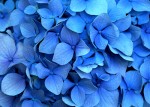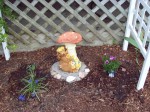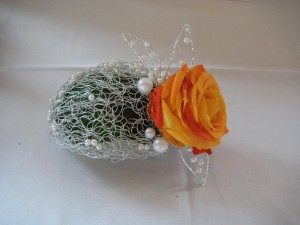Adding cool blue to your garden lends a feeling of calmness and restfulness. Because there are so few flowers that are truly blue, this color is most coveted by gardeners. One of the most beautiful blue flowers in the world is the Blue Himalayan poppy (Meconopsis betonicifolia). I haven’t tried to grow them because they are temperamental and quite a challenge to grow in hotter areas, such as my Zone 7. The sight of a cluster of Blue Himalayan poppies blowing in the breeze will make you sigh.
Introduce lovely old-fashioned ‘Nikko Blue’ or ‘Blue Wave’ hydrangea to your garden as a foundation plant. Hydrangeas have the ability to change color based on the alkalinity of the soil. That means even the lovely ‘Nikko Blue’ has a chance at blooming pink instead of blue! The bloom colors will be pink in alkaline soil. In more acidic soil (5.2-5.5ph), the bloom colors are blue. To ensure that stunning blue hue, you need to manipulate your soil’s pH level and mineral content. This must be done several times during the growing season. You can lower the pH by watering with 2 tbsp of aluminum sulfate per gallon of water. The results are well worth the extra effort!
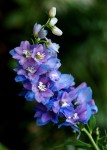 Consider the enchanting Delphinium (also known as Larkspur). Delphinium derives its genus’ name from the Greek word for “dolphin” and is suggested by the shape of a gland in the blossoms that secretes nectar. Delphiniums make wonderful long-lasting cut flowers and bloom in red, blue and yellow, as well as blended varieties. They prefer cool, moist places and bloom in late spring. Often growing six to eight feet tall, there are some dwarf varieties that top out at just two feet in height. They grow best in full sun, but will tolerate partial shade, and need staking to keep the stems upright. Keep the soil moist to feed quick growth and add a general purpose fertilizer once a month until they have bloomed.
Consider the enchanting Delphinium (also known as Larkspur). Delphinium derives its genus’ name from the Greek word for “dolphin” and is suggested by the shape of a gland in the blossoms that secretes nectar. Delphiniums make wonderful long-lasting cut flowers and bloom in red, blue and yellow, as well as blended varieties. They prefer cool, moist places and bloom in late spring. Often growing six to eight feet tall, there are some dwarf varieties that top out at just two feet in height. They grow best in full sun, but will tolerate partial shade, and need staking to keep the stems upright. Keep the soil moist to feed quick growth and add a general purpose fertilizer once a month until they have bloomed.
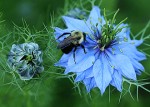 The ethereal, light and airy Love-in-a-Mist (Nigella damascena) is a beautiful Victorian garden annual blooming in soft shades of blue, pink, white, and lavender. This annual herbaceous plant is in the buttercup family (Ranunculaceae), readily self-seeds, and is common in old-fashioned cottage gardens. It grows in full sun to partial shade and blooms from late spring through fall. Nigella is short-lived, so for continuous bloom, repeat sowing every four weeks. You can cut and deadhead this plant to keep it flowering longer.
The ethereal, light and airy Love-in-a-Mist (Nigella damascena) is a beautiful Victorian garden annual blooming in soft shades of blue, pink, white, and lavender. This annual herbaceous plant is in the buttercup family (Ranunculaceae), readily self-seeds, and is common in old-fashioned cottage gardens. It grows in full sun to partial shade and blooms from late spring through fall. Nigella is short-lived, so for continuous bloom, repeat sowing every four weeks. You can cut and deadhead this plant to keep it flowering longer.
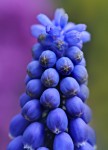 It just wouldn’t be spring without masses of tiny Grape Hyacinths (Muscari) planted as bulbs in swaths throughout your garden. Growing no more than 10 inches tall, the tight conical heads of tiny round flowers do look like clusters of grapes. Blue is a predominant color but they also come in pale ice blue, white and yellow. Muscari, a member of the Lily family, are quite prolific, making them perfect for naturalizing. Look for the popular ‘Heavenly Blue’, bright blue ‘Dark Eyes’, mid-blue ‘Cote d’Azur’, sky blue ‘Valerie Finnis’, and the frosty ‘Blue Spike’. I have the double-flowered ‘Fantasy Creation’ variety in my garden—their flower heads look like clusters of blue broccoli! Easy to grow in full sun to part shade in zones 3-9 and low-maintenance—what’s not to love about these little blue jewels?
It just wouldn’t be spring without masses of tiny Grape Hyacinths (Muscari) planted as bulbs in swaths throughout your garden. Growing no more than 10 inches tall, the tight conical heads of tiny round flowers do look like clusters of grapes. Blue is a predominant color but they also come in pale ice blue, white and yellow. Muscari, a member of the Lily family, are quite prolific, making them perfect for naturalizing. Look for the popular ‘Heavenly Blue’, bright blue ‘Dark Eyes’, mid-blue ‘Cote d’Azur’, sky blue ‘Valerie Finnis’, and the frosty ‘Blue Spike’. I have the double-flowered ‘Fantasy Creation’ variety in my garden—their flower heads look like clusters of blue broccoli! Easy to grow in full sun to part shade in zones 3-9 and low-maintenance—what’s not to love about these little blue jewels?
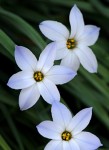 Star-shaped, pale blue Spring Starflower (Ipheion uniflorum), with grass-like foliage is a spring perennial grown from bulbs and is very long-blooming (3-5 weeks). This plant naturalizes very swiftly, spreading by self-seeding and from bulb offsets. Often used in rock gardens and woodland gardens, they grow just 4-5 inches tall, and are perennials in Zones 6 to 7 (with mulching to protect from frost) and in Zones 8 to 9 without mulching. They can be grown in full sun to part shade, require medium watering, and are low maintenance.
Star-shaped, pale blue Spring Starflower (Ipheion uniflorum), with grass-like foliage is a spring perennial grown from bulbs and is very long-blooming (3-5 weeks). This plant naturalizes very swiftly, spreading by self-seeding and from bulb offsets. Often used in rock gardens and woodland gardens, they grow just 4-5 inches tall, and are perennials in Zones 6 to 7 (with mulching to protect from frost) and in Zones 8 to 9 without mulching. They can be grown in full sun to part shade, require medium watering, and are low maintenance.
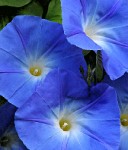 In my humble opinion, a garden without ‘Heavenly Blue’ Morning Glories (Ipomoea tricolor) is incomplete. Their fleeting beauty will take your breath away. These vigorous climbers are grown from seed and will cover a trellis or wall in just one season- growing up to 20 feet and blooming prolifically. One year, I counted over 300 blooms on the vines that covered my front wall! An herbaceous annual twining vine, it will reach out in a clockwise direction and take hold of anything near it. The 4-5″ trumphet-shaped flowers come in a variety of other colors, including reds, pinks and purples—but there’s nothing more heavenly than the classic ‘Heavenly Blue’ variety.
In my humble opinion, a garden without ‘Heavenly Blue’ Morning Glories (Ipomoea tricolor) is incomplete. Their fleeting beauty will take your breath away. These vigorous climbers are grown from seed and will cover a trellis or wall in just one season- growing up to 20 feet and blooming prolifically. One year, I counted over 300 blooms on the vines that covered my front wall! An herbaceous annual twining vine, it will reach out in a clockwise direction and take hold of anything near it. The 4-5″ trumphet-shaped flowers come in a variety of other colors, including reds, pinks and purples—but there’s nothing more heavenly than the classic ‘Heavenly Blue’ variety.
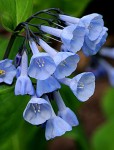 The buds of the herbaceous perennial Virginia Bluebell (Mertensia virginica), a member of the Borage family, begin as a pinkish shade and transform into pale blue-violet colored, trumphet-shaped flowers as they mature. Blooming in mid-to-late spring, they can be found growing en masse in moist woodland areas in partial to full shade. Plant them with hostas and ferns as companion plants.
The buds of the herbaceous perennial Virginia Bluebell (Mertensia virginica), a member of the Borage family, begin as a pinkish shade and transform into pale blue-violet colored, trumphet-shaped flowers as they mature. Blooming in mid-to-late spring, they can be found growing en masse in moist woodland areas in partial to full shade. Plant them with hostas and ferns as companion plants.
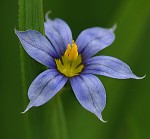 Best planted in large groups for maximum visual impact, Blue-eyed grass (Sisyrinchium angustifolium), a member of the Iris family, is a late spring-blooming perennial with very tiny (less than 1/2 inch!) iris-like blue flowers with yellow centers. Blue-eyed Grass does well in moist areas with some sun, and if happy in its spot, will spread to form stands. Its diminutive size makes it great for adding a grasslike addition to a small garden where ornamental grass would be overwhelming.
Best planted in large groups for maximum visual impact, Blue-eyed grass (Sisyrinchium angustifolium), a member of the Iris family, is a late spring-blooming perennial with very tiny (less than 1/2 inch!) iris-like blue flowers with yellow centers. Blue-eyed Grass does well in moist areas with some sun, and if happy in its spot, will spread to form stands. Its diminutive size makes it great for adding a grasslike addition to a small garden where ornamental grass would be overwhelming.
 This Hardy Geranium (Geranium ‘Brookside’ cultivar), also known as Cranesbill, is a deciduous, herbaceous perennial that forms a neat mound that is about 18″ high and wide. Flowering begins in spring. If you cut it back after flowering, it should bloom again in the summer. It makes a great filler for mixed borders or full-sun perennial beds and grows well in containers. It prefers full sun but can tolerate part shade for half of the day. It does best in moist, well-drained soil. Hardy in zones 5-8.
This Hardy Geranium (Geranium ‘Brookside’ cultivar), also known as Cranesbill, is a deciduous, herbaceous perennial that forms a neat mound that is about 18″ high and wide. Flowering begins in spring. If you cut it back after flowering, it should bloom again in the summer. It makes a great filler for mixed borders or full-sun perennial beds and grows well in containers. It prefers full sun but can tolerate part shade for half of the day. It does best in moist, well-drained soil. Hardy in zones 5-8.
Salvias also provide that saturated blue color that gardeners seek. Look for Mealycup Sage (Salvia farinacea ‘Victoria Blue’), a member of the mint family. This herbaceous perennial is commonly grown as an annual in cold areas. Striped Squill (Puschkinia libanotica) is a beautiful spring bulb flower growing just 4-5 inches tall, with pale white-blue petals with darker blue center stripes. If you’re an Iris fan, look for the lovely blossoms of the Giant Blue Flag Louisiana Iris (Iris giganticaerulea) with its four foot stems; or ‘Sky Beauty’ Dutch Iris with its combination of white and french blue petals with a single lemon yellow blotch. Agapanthus, or ‘Lily of the Nile’, with its blue ball-shaped clusters and funnel-shaped flowers on four foot stems, is a showy addition to any garden.
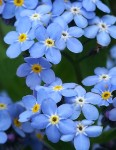 And finally, we can’t forget the diminutive Forget-Me-Nots (Myosotis alpestris)! This perennial grows 5-12 inches high in alpine meadows (or your garden!). Each dainty flower is a mere 1/3 inch wide, with sky blue petals, a white inner ring, and a tiny yellow center. Blooming in May and June, hardy Forget-Me-Nots prefer partial shade and spread by reseeding. These charming old fashioned flowers can help fill in the blanks in your garden!
And finally, we can’t forget the diminutive Forget-Me-Nots (Myosotis alpestris)! This perennial grows 5-12 inches high in alpine meadows (or your garden!). Each dainty flower is a mere 1/3 inch wide, with sky blue petals, a white inner ring, and a tiny yellow center. Blooming in May and June, hardy Forget-Me-Nots prefer partial shade and spread by reseeding. These charming old fashioned flowers can help fill in the blanks in your garden!
If you don’t have the blues, you certainly should – for your garden, that is!
Don’t keep the blues to yourself. Did you know that local florists use many of these blue flowers, Hydrangea, Delphinium, Niegella, Grape Hyacinths, Iris, Agapanthus, and Forget-me-nots, in flower arrangements? So even if you don’t have a garden full of blue flowers, you can share a beautiful blue bouquet with a friend.
Cindy Dyer is a freelance graphic designer and photographer in Alexandria, Virginia. Visit her blog at www.cindydyer.wordpress.com and her botanical gallery at www.cindydyer.zenfolio.com. She can reached at dyerdesign@aol.com. All photos © Cindy Dyer, unless specified otherwise.


 Find Your
Find Your 
